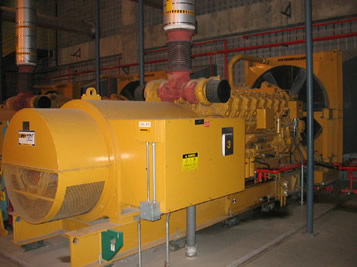Industrial Generator FAQ (Frequently Asked Questions)
 At Generator Source, many of our customers rely upon us to provide them with accurate and informative answers to their electrical, engine, and generator related questions. This results in numerous questions every day, some of which are quite common and we answer quite frequently. In order to better inform our customers and website visitors alike on some of the most popular topics and issues we encounter, we have decided to begin a list of Frequently Asked Questions. We plan to expand uponthis section over time and add any other commonly asked question that we encounter. If you have any additional questions you would like to see showcased here please email us with your suggestions and we will do our best to answer and incorporate them here.
At Generator Source, many of our customers rely upon us to provide them with accurate and informative answers to their electrical, engine, and generator related questions. This results in numerous questions every day, some of which are quite common and we answer quite frequently. In order to better inform our customers and website visitors alike on some of the most popular topics and issues we encounter, we have decided to begin a list of Frequently Asked Questions. We plan to expand uponthis section over time and add any other commonly asked question that we encounter. If you have any additional questions you would like to see showcased here please email us with your suggestions and we will do our best to answer and incorporate them here.
1. What is the difference between kW and kVa?
2. What is a power factor?
3. What is the difference between standby, continuous, and prime power ratings?
4. If I am interested in a generator that is not the voltage I need, can the voltage be changed?
5. What does an Automatic Transfer Switch do?
6. Can a generator I am looking at parallel with one I already own?
7. Can you convert a 60 Hz generator to 50 Hz?
8. How do I determine what size Generator I need?
What is the difference between kW and kVa?
The primary difference between kW (kilowatt) and kVA (kilovolt-ampere) is the power factor. kW is the unit of real power and kVA is a unit of apparent power (or real power plus re-active power). The power factor, unless it is defined and known, is therefore an approximate value (typically 0.8), and the kVA value will always be higher than the value for kW.
In relation to industrial and commercial generators, kW is most commonly used when referring to generators in the United States, and a few other countries that use 60 Hz, while the majority of the rest of the world typically uses kVa as the primary value when referencing generator sets.
To expand on it a bit more, the kW rating is essentially the resulting power output a generator can supply based on the horsepower of an engine. kW is figured by the horsepower rating of the engine times .746. For example if you have a 500 horsepower engine it has a kW rating of 373. The kilovolt-amperes (kVa) are the generator end capacity. Generator sets are usually shown with both ratings. To determine the kW and kVa ratio the formula below is used.
.8 (pf) x 625 (kVa) = 500 kW
What is a power factor?
The power factor (pf) is typically defined as the ratio between kilowatts (kW) and kilovolt amps (kVa) that is drawn from an electrical load, as was discussed in the question above in more detail. It is determined by the generators connected load. The pf on the nameplate of a generator relates the kVa to the kW rating (see formula above). Generators with higher power factors more efficiently transfer energy to the connected load, while generators with a lower power factor are not as efficient and result in increased power costs. The standard power factor for a three phase generator is .8.
What is the difference between standby, continuous, and prime power ratings?
Standby power generators are most often used in emergency situations, such as during a power outage. It is ideal for applications that have another reliable continuous power source like utility power. It’s recommend usage is most often only for the duration of a power outage and regular testing and maintenance.
Prime power ratings can be defined as having an “unlimited run time”, or essentially a generator that will be used as a primary power source and not just for standby or backup power. A prime power rated generator can supply power in a situation where there is no utility source, as is often the case in industrial applications like mining or oil & gas operations located in remote areas where the grid is not accessible.
Continuous power is similar to prime power but has a base load rating. It can supply power continuously to a constant load, but does not have the ability to handle overload conditions or work as well with variable loads. The main difference between a prime and continuous rating is that prime power gensets are set to have maximum power available at a variable load for an unlimited number of hours, and they generally include a 10% or so overload capability for short durations.
If I am interested in a generator that is not the voltage I need, can the voltage be changed?
Generator ends are designed to be either reconnectable or non-reconnectable. If a generator is listed as reconnectable the voltage can be changed, consequently if it is non-reconnectable the voltage is not changeable. 12-lead reconnectable generator ends can be changed between three and single phase voltages; however, keep in mind that a voltage change from three phase to single phase will decrease the power out put of the machine. 10 lead reconnectable can converted to three phase voltages but not single phase. For more information, here’s a uthis informative article on changing voltages.
What does an Automatic Transfer Switch do?
An automatic transfer switch (ATS) transfers power from a standard source, like utility, to emergency power, such as a generator, when the standard source fails. An ATS senses the power interruption on the line and in turn signals the engine panel to start. When the standard source is restored to normal power the ATS transfers power back to the standard source and shuts the generator down. Automatic Transfer Switches are often used in high availability environments such as data centers, manufacturing plans, telecommunication networks and so forth.
Can a generator I am looking at parallel with one I already own?
Generator sets can be paralleled for either redundancy or capacity requirements. Paralleling generators allows you to electrically join them to combine their power output. Paralleling identical generators will not be problematic but some extensive thought should go into the overall design based on the primary purpose of your system. If you are trying to parallel unlike generators the design and installation can be more complex and you must keep in mind the affects of engine configuration, generator design, and regulator design, just to name a few. For more information and details on paralleling standby generators in critical systems take a look at this informative article.
Can you convert a 60 Hz generator to 50 Hz?
In general, most commercial generators can be converted from 60 Hz to 50 Hz. The general rule of thumb is 60 Hz machines run at 1800 Rpm and 50 Hz generators run at 1500 Rpm. With most generators changing the frequency will only require turning down the rpm’s of the engine. In some cases, parts may have to be replaced or further modifications made. Larger machines or machines already set at low Rpm are different and should always be evaluated on a case by case basis. We prefer to have our experienced technicians look at each generator in detail in order to determine the feasibility and what all will be required.
How do I determine what size Generator I need?
Getting a generator that can handle all your power generation needs is one of the most critical aspects of the purchasing decision. Whether you are interested in prime or standby power, if your new generator can't meet your specific requirements then it simply won't be doing anyone any good because it can put undue stress on the unit and even damage some of the devices connected to it. Determining exactly what size of generator to get is often very difficult and involves a number of factors and considerations. To get more detailed information on this subject, please visit our expanded article on Sizing a Generator.